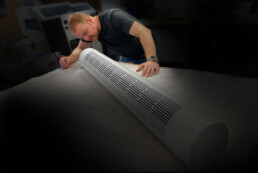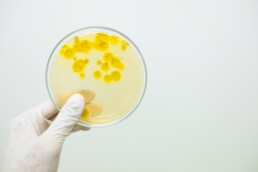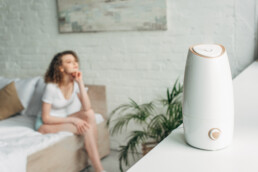Innovative Air Quality Tech Unveiled at CES 2024 and Beyond
From January 9th to 12th, the tech industry's brightest minds traveled to Las Vegas to attend CES 2024 (Consumer Electronics Show). This annual event showcased the latest technology innovations and groundbreaking companies, offering a sneak peek into the future of tech. This year's conference featured a wide range of revolutionary products and advancements in various industries.

One area that stood out was the focus on air quality technology. With growing concerns about indoor air quality, pollution, and climate change, it's no surprise that companies are investing in ways to improve air quality for both personal and public use. Keep reading to explore a selection of the most fascinating air quality products that were showcased at CES, as well as a glimpse into a first-in-class device, paving a new era of indoor air quality technology.
Latest Air Quality Products Unveiled at CES
1. Moss Air by Taiga Inc.
As a CES 2024 Innovation Award Product Honoree, this product was by far the most captivating. Described as a "desktop-sized humidifier and purifier," what sets this device apart is its use of moss technology, which mimics nature's natural filtration system. Moss Air harnesses the power of moss to effectively capture carbon dioxide. Its innovative moss panel filters not only trap fine dust particles but also convert carbon dioxide into oxygen. This groundbreaking solution seamlessly combines nature's efficiency with air purification technology.
Read more about Moss Air here.
2. Airthings Renew Air Purifier and Wave Enhance
Airthings launched 2 new products at CES, introducing the Wave Enhance, an air quality monitor, along with their first ever "smart air purifier", Airthings Renew. The company's very first smart air purifier, crafted in Scandinavia by indoor air quality experts, was created with the idea that fresh, revitalizing air belongs in your home. Airthings Renew is equipped with a powerful 4-stage HEPA-13 filter, which effectively eliminates up to 99.97% of particulates. Additionally, its high-performance carbon filter is able to remove gasses and odors from the air. The sleek and modern device claims to "fully cleanse the air in the typical bedroom within 10 minutes."
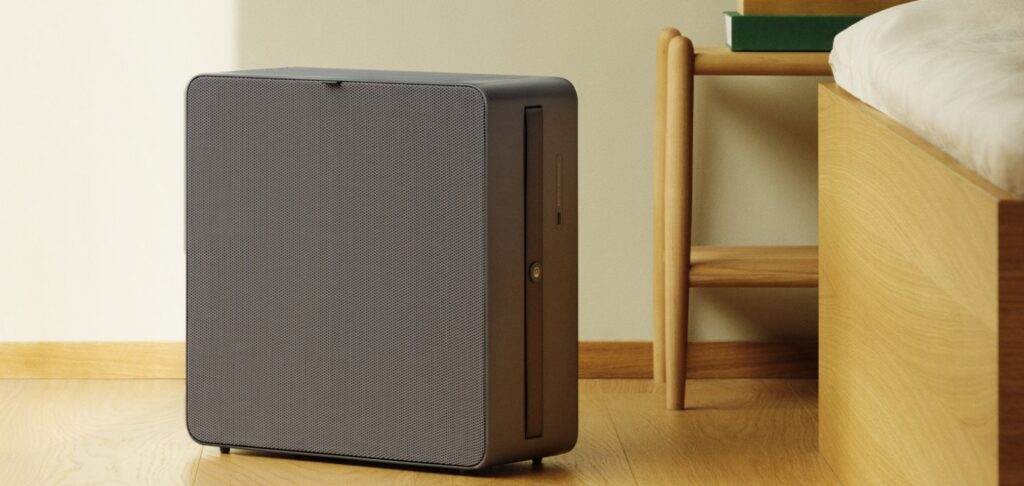
Read more about Airthings Renew here.
3. Ultrahuman Home
Similar to the Airthings Wave Enhance, Ultrahuman displayed their innovative home health tracker at CES 2024. Ultrahuman Home is made to be a personal home environment monitor that delivers comprehensive insights about your home's health straight to the Ultrahuman app, providing you with "scores" and actionable tips to improve your home's well-being. Its advanced sensors monitor everything from light levels to air pollution, humidity, noise, and even smoke, ensuring your environment is as healthy as can be.
Read More about Ultrahuman Home here.
4. Woosh Smart Air Filter and Air Quality Monitor
At CES 2024, Woosh unveiled two innovative products that prioritize indoor air quality. Aside from introducing an innovative air quality monitor, they captivated the audience with their advanced smart air filter. The Woosh Smart Air Filter provides a modernized, high-tech solution to air filtration. Featuring highly accurate filter sensors, secure magnet installation, and optional gasketing for the perfect fit, this filter is designed with precision and convenience in mind. Through the Woosh Air app, users are able to see the quality of their HVAC filter in real time and receive alerts when it needs to be replaced.
Read more about Woosh Smart Air Filter here.
5. Mila HomeKit Air Quality Solutions
Mila wowed the crowd at CES 2024 with their impressive lineup of air quality products- all compatible with Apple HomeKit. Their most notable at the conference was their new combined humidifier and air purifier, the Mila Halo. This 2-in-1 device that merges a humidifier and an air purifier eliminates both inorganic and organic contaminants, like bacteria and fungi, providing clean and healthy air. With intelligent controls and customizable design, Mila Halo is a stylish and innovative device for any home.
Read more about Mila's air quality products here.
Beyond CES: Air Quality Products on the Rise
After exploring the impressive air quality innovations at CES 2024, it's clear the industry is making strides towards healthier indoor environments, but CES isn't the only platform for new air quality products. Other players in the market are also delivering innovative solutions to enhance indoor air quality with cutting-edge technology.
1. AURA Ion Bar
The AURA Ion Bar is a game-changing innovation that's set to redefine the way we think about indoor air quality. Unlike traditional purifiers that clean the air after 20-30 minutes, this revolutionary device creates an entirely new category- it blocks contaminants before they have a chance to enter your space! With its dual-protection system, it creates a germicidal barrier using a gentle air curtain infused with Negative Air Ions (NAIs).
These powerful NAIs effectively block and reduce the transfer of COVID-19 by a staggering 99.98%. The goal is to replace plastic shields with germ-eliminating air, creating a safe environment to bring people back together. When it comes to stopping the spread of COVID between two people, Ion Bar has been shown to provide a staggering 100x more protection than an N95 mask.

Picture this: an Ion Bar installed above the checkout of a cafe, ensuring the safety of both workers and customers by shielding them from contaminated air. Now, you can enjoy your favorite cafe with peace of mind, knowing that your indoor air quality is protected. And, because Ion Bar is whisper-quiet, you and the barista can enjoy natural interactions without a plastic wall separating you.
The AURA Ion Bar is here to revolutionize your indoor air experience. Read more about Ion Bar here.
2. WellisAir Pure
WellisAir is advanced air purifying technology that creates a healthier living environment. Using proactive "hydropure" molecular technology, it effectively removes smoke, viruses, bacteria, allergens, and other pollutants with a 99.9% success rate. Mimicking the natural process of hydroxyl creation, this eco-friendly solution is safe for children and pets, operating quietly and consuming minimal energy.
Read more about WellisAir Pure here.
3. AirVisual Pro Indoor Monitor
Experience peace of mind and healthier air with IQAir's AirVisual Pro Indoor Monitor. This innovative and stylish device effectively monitors air quality levels in your home, school, or business. It measures a wide range of pollutants, including those from cooking, cleaning, wood burning, smoking, wildfire smoke, and traffic pollution. Users are able to stay informed about real-time and historic air quality through the IQAir AirVisual app.
Read more about AirVisual Pro Indoor Monitor here.
These advancements in air quality technology are not just impressive, but crucial in today's world. The products showcased at CES 2024, and others mentioned, are paving the way for a new era of indoor air quality preservation. As the industry continues to innovate, we hope to see even more solutions that contribute to healthier living environments, ultimately improving the quality of life for so many.
Sources:
- Innovation Award Honorees (ces.tech)
- Moss air | Refreshen and Hydrate with Nature's Breath (mosslab-air.com)
- Airthings Kicks Off CES 2024 with Launch of Two New Products, Including Renew, Airthings’ First-Ever Smart Air Purifier
- Renew - Smart air purifier from Airthings | Airthings
- Wave Enhance - indoor air quality monitor to help sleep better (airthings.com)
- Smart ring maker Ultrahuman announces tracker for home ‘health’ | TechCrunch
- Cyborg-Ultrahuman
- CES 2024: This Smart Device Can Tell You When It's Time to Change Your HVAC Filter | HomeServe USA
- Smart Air Filter (wooshair.com)
- Air Quality Monitor (wooshair.com)
- CES 2024: Mila leads the way with HomeKit air quality solutions (appleinsider.com)
- Mila Cares | How Mila is Different
- AURA Ion Bar™ | AURA Ion Bar™
- See the New 'Game-Changing' Tech That Kills COVID-19, Other Viruses (newsweek.com)
- AURATechnologies-IonBar-COVID-TestResults2022.pdf (auraionbar.com)
- Introducing: AURA Ion Bar™ | AURA Ion Bar™
- Hydroxyl Air Purifier | OH Radical Technology - Wellis Air USA – WellisAir USA (wellisairpure.com)
- Clinically Proven – WellisAir USA (wellisairpure.com)
- AirVisual Series Air Quality Monitors | IQAir
The Impact of Outdoor Air Pollution on Indoor Air Quality
The recent increase in wildfires has dramatically heightened concerns about air quality, both outdoors and indoors. These devastating fires release harmful particulates and pollutants, making the air outside dangerous to breathe. The gasses produced by wildfires can affect outdoor air quality hundreds of miles away- even when the smoke is not visible. However, their impact doesn't stop there; these pollutants can also invade indoor spaces and gradually make our indoor air quality worse. These days, ensuring the quality of our indoor air has become a top priority, but to achieve this, it's crucial to have a solid grasp on how it all works.

Understanding Air Pollution
Outdoor air pollution is not a new concern, it has simply gained more attention because of the increase in wildfires. Dealing with air pollution has always been a challenge. In 2019, 99% of the world’s population lived in places with air quality below WHO (World Health Association) guidelines.2 A significant portion of our air pollution is a result of our own actions. Industrial emissions from factories, power plants, burning fossil fuels, vehicle exhaust, deforestation, and other activities all contribute to the gradual decline in air quality. While some of these things are simply out of our control, our indoor air quality is something that we can preserve.
How Outdoor Air Becomes Indoor Air
Outdoor air pollutants can easily find their way into indoor environments through various means. They sneak in through ventilation systems, open windows and doors, and even attached garages. These entry points act as gateways for harmful substances such as dust, pollen, smoke, carbon monoxide, and other pollutants. It's crucial to be aware of these entry points so we can take measures to ensure clean and healthy indoor air quality.
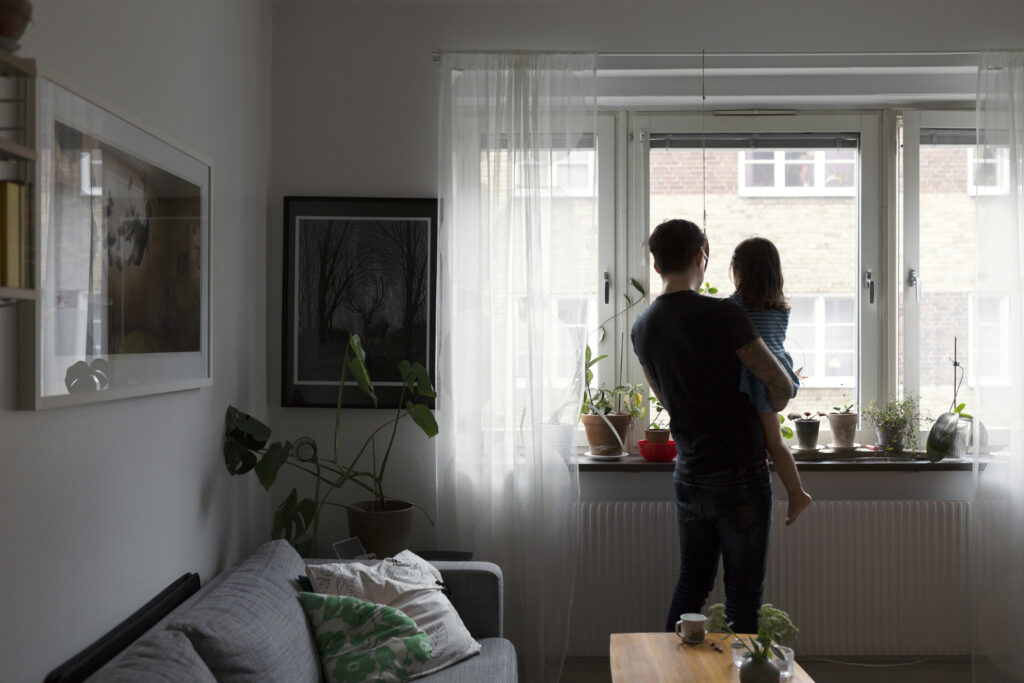
You can easily check the air quality in your specific area by visiting reliable websites like Air Now. It's a great way to stay aware and prepared, as you can get real-time updates on the current air quality index in your area. If the outdoor air quality is poor, you might want to consider skipping outdoor activities and opting for indoor alternatives. Keeping your windows closed can also help lower the entry of outdoor pollutants into your living space, creating a healthier environment for you and your loved ones.
The Risks of Poor Indoor Air Quality
Outdoor pollutants that find their way indoors can drastically reduce the quality of indoor air and cause a number of health problems. Outdoor contaminants can trigger allergies, causing symptoms like sneezing, itchy eyes, and throat irritation. More troublingly, they can worsen respiratory conditions such as asthma, leading to more frequent and severe attacks.
Extended exposure to these pollutants can also result in the development of other respiratory diseases and complications, like chronic obstructive pulmonary disease (COPD) and even lung cancer. When we consider these potential health impacts, it becomes evident that maintaining safe indoor air quality is not only about comfort, but also about our health and well-being.
While the declining outdoor air quality cannot be easily fixed, there are proactive measures you can take to keep your indoor environment safe and healthy. Check out this article, where we provide you with 5 ways to preserve your indoor air quality. By using these strategies, you can create a sanctuary within your home that promotes well-being and reduces the impact of outdoor pollutants on your health.
Resources
- 3 reasons wildfires are getting more dangerous—and 3 ways to make things better | The Wilderness Society
- Ambient (outdoor) air pollution (who.int)
- What are the WHO Air quality guidelines?
- COPD - Symptoms and causes - Mayo Clinic
- AirNow.gov
5 Easy Steps to Preserve Indoor Air Quality
A recent episode of CBS's 60 Minutes shined a spotlight on the importance of maintaining clean indoor air, an aspect that was largely overlooked during the spread of Covid. In today's world, preserving indoor air quality should be a high priority. According to the EPA (United States Environmental Protection Agency), Americans, on average, spend approximately 90 percent of their time indoors,1 where the concentrations of some pollutants are often 2 to 5 times higher than typical outdoor concentrations.2 With all this time spent indoors, protecting your indoor air quality is more important than ever. Indoor quality not only affects your health, but could potentially be affecting your focus and productivity as well.3
Whether you're concerned about safeguarding your indoor air quality from wildfires or dealing with allergies, ensuring clean air is a necessity. Here are 5 common ways to preserve your indoor air quality and keep your spaces safe.
- Ventilate Your Home
- Invest in an Indoor Air Quality System
- Maintain Your HVAC System
- Clean Regularly
- Reduce Chemical Pollutants
1. Ventilate Your Home
One great way to maintain good indoor air quality is by ensuring proper ventilation in your home. Simply opening windows or doors regularly allows fresh air to circulate, replacing any stale or potentially contaminated air. However, it's important to note that this may not always be an option for everyone. Nowadays, there are various reasons why people cannot rely on ventilation through open windows and doors. In some cases, the air quality outside is worse than indoors. As a result, this option has become less popular recently.

2. Invest in an Indoor Air Quality System
When outdoor air quality is poor due to wildfires or other pollutants, air purifiers can be another solution. They work to filter out harmful particles and chemicals and improve indoor air quality. However, when purchasing an air purifier that uses a filter to trap contaminants and control ozone output, there are a few risks to keep in mind.
Filters and filter replacements can be costly, which means most people tend to put off changing the filter until absolutely necessary- but it's crucial to remember that delaying filter changes can actually worsen the air quality in your home. Moreover, if the filter is not working properly, you may inadvertently allow the escape of ozone into your home, which defeats the purpose of having an air purifier. So, it's important to stay mindful of these factors when using an air purifier.
While air purifiers work to clean air that has already been contaminated, there is a new product on the market that offers a brighter future. The filter-free AURA Ion Bar™ uses linear airflow and negative air ions to block contaminants and pollutants before they enter your space, making it a more efficient and cost-effective solution. Using an Ion Bar in addition to other indoor air quality systems can help to protect and improve your indoor air quality.
If you'd like to learn more about Ion Bar and how it works, click here.
3. Maintain Your HVAC System
Regular maintenance of your heating, ventilation, and air conditioning (HVAC) system is crucial for preserving good indoor air quality. By regularly inspecting and cleaning the various parts of your HVAC system (filters, coils, and ducts), you can remove dust, allergens, and other pollutants that negatively impact the air you breathe. Making sure to regularly maintain the filters in your HVAC system is crucial. It keeps everything running smoothly and efficiently, which is very important for protecting your indoor air quality. In addition, following the manufacturer's recommendations for filter replacement and scheduling professional tune-ups can help prevent system malfunctions and maximize energy efficiency.
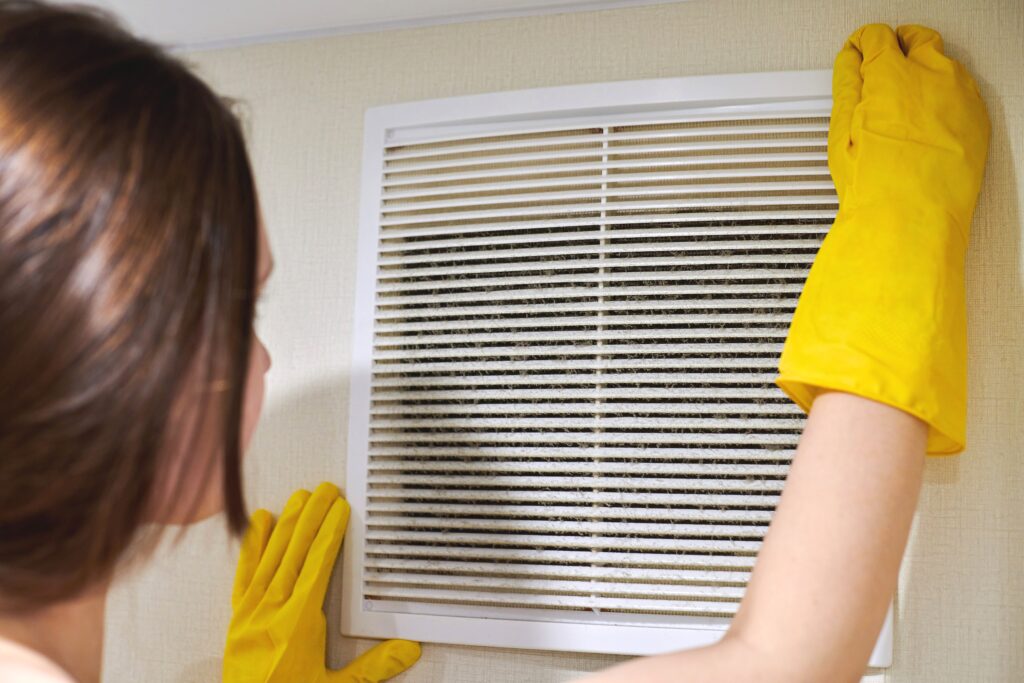
4. Clean Regularly
Maintaining cleanliness in your home is essential to preserve good indoor air quality. Regular dusting, vacuuming, and cleaning of household materials like rugs, fabric furniture, and carpets can go a long way in reducing indoor pollutants and allergens. By removing things like dust mites, pet dander, and other particles, you create a healthier living environment. Keeping your home clean can also help prevent the spread of bacteria and viruses, ensuring a safer and more hygienic space for you and your loved ones.
5. Reduce Chemical Pollutants
While cleaning is a great way to keep your home safe, it is important to be aware of the cleaning products you use. Attempting to limit the use of products that emit Volatile Organic Compounds (VOCs), such as certain paints, varnishes, and cleaning supplies will help preserve indoor air quality. Instead, opt for low-VOC or eco-friendly cleaning products that are less harmful to your health and the environment. You may also wish to consider using high VOC products outdoors, if possible, to avoid introducing them into your home.
By following these five simple steps, you can significantly improve your indoor air quality. Investing in an indoor air quality system like AURA Ion Bar™, along with regular maintenance, is a great way to ensure clean and healthy indoor air.
Resources
- U.S. Environmental Protection Agency. 1989. Report to Congress on indoor air quality: Volume 2. EPA/400/1-89/001C. Washington, DC.
- Indoor Air Quality | US EPA
- U.S. Environmental Protection Agency. 2003. Indoor air quality and student performance. EPA/402/K-03/006. Washington, DC.
- Indoor air systems crucial to curbing spread of viruses, aerosol researchers say - CBS News
- AURA Ion Bar | AURA Ion Bar™
- The Power of Negative Ions | AURA Ion Bar™
- Introducing: AURA Ion Bar™ | AURA Ion Bar™
- What are volatile organic compounds (VOCs)? | US EPA
AURA Ion Bar VS. Covid-19
Amidst the rise of Covid-19, we were urged to mask up, keep our distance, and wash our hands frequently. But as the pandemic unfolded, research showed that the virus could travel through the air well beyond six feet and linger in the air for several hours. In a revealing episode of CBS's 60 Minutes, air quality scientists highlighted that protecting our indoor air quality should have been just as important – if not more important – than other preventative measures to slow the spread.
In a market flooded with products lacking adequate testing, the AURA team was determined to put in the work needed to guarantee a product that performed as advertised and one that prioritized safety. The AURA Ion Bar was meticulously designed with safety in mind. However, what good is safety if it doesn't deliver results? To ensure its effectiveness, the AURA team conducted thorough testing of the Ion Bar, including testing against aerosolized SARS-CoV-2 (Covid-19), and the results speak volumes.
The Testing
"It should all work in principle, but will it work in practice?" This is the question that Alex Blate, PhD, Chief Innovator at AURA and others were asking themselves ahead of lab testing the Ion Bar. They had done the work on paper, but now was the real test.
The team began by finding an accredited lab that was able to perform aerosol testing with real SARS-CoV-2 virus samples. Innovative Bioanalysis, a lab based in Costa Mesa, California, was the one to take on the job. One of the studies conducted, titled AURA TECHNOLOGIES ION BAR EFFICACY IN SARS-COV-2 DEACTIVATION, took place over the course of 6 weeks in 2021. Conducted in a controlled laboratory environment, the study included testing with aerosolized SARS-CoV-2 to assess the effectiveness of the AURA Tech Ion Bar against the known pathogen.
The 20 ft x 8 ft x 8 ft testing chamber was maintained at a temperature of 77.2 °F ± 2 °F with a relative humidity of 49%. The chamber had a displacement volume of 1,280 ft3 (36,246 L) of air and remained sealed during testing. Most testing rooms for other indoor air quality products are not this size, giving skewed and unreliable test results. The AURA team was committed to thoroughly testing Ion Bar in a larger room, ensuring more accurate test results of how the Ion Bar would work in a real-life setting.
Dr. Blate recalled that a new test protocol had to be created for Ion Bar. "There's no device like Ion Bar out there. It's the first of its kind, so they didn't have an 'off-the-shelf' protocol that they could use." Ion Bar is the first of its kind to block contaminants from your space before they enter. This required a unique testing chamber. Inside the chamber, a simulated wall with a doorway frame was constructed to split the chamber into two 10 ft x 8 ft x 8 ft sections with the Ion Bar mounted above the doorway, approximately 7 ft above the floor on the "clean" side.
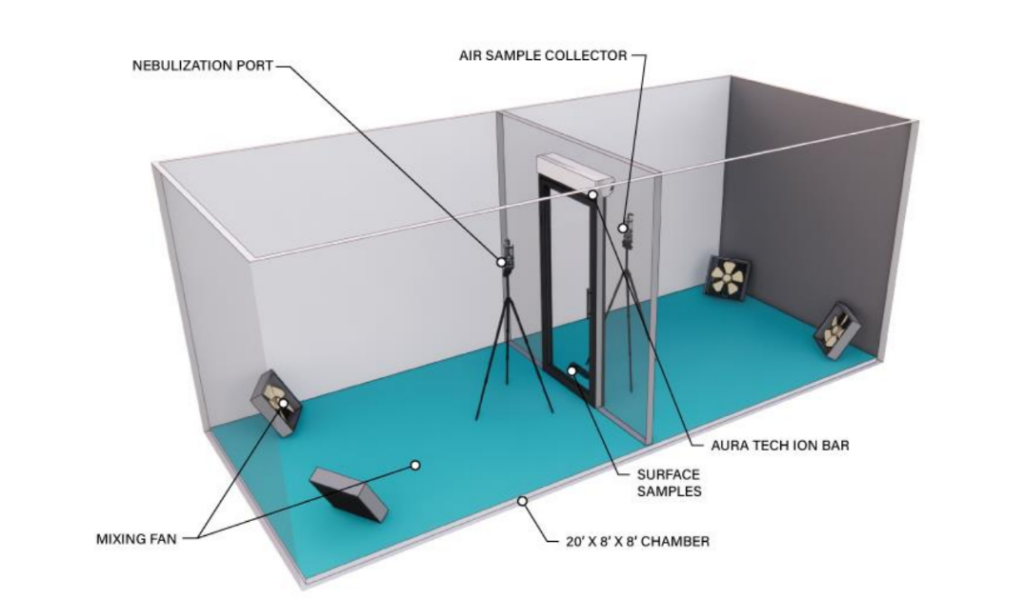 We needed to release the Covid virus into the room and onto surfaces similarly to the way the virus would naturally spread. To do this, a viral media containing 6.32 × 106 TCID50/mL* of SARS-CoV-2 was inoculated onto glass slides as control and challenge samples for surface testing, using fetal bovine serum (FBS) as a base.
We needed to release the Covid virus into the room and onto surfaces similarly to the way the virus would naturally spread. To do this, a viral media containing 6.32 × 106 TCID50/mL* of SARS-CoV-2 was inoculated onto glass slides as control and challenge samples for surface testing, using fetal bovine serum (FBS) as a base.
For the aerosol testing, the same concentration of the virus was used, but instead of using glass slides, the virus was nebulized and sprayed into the room. This simulated its natural airborne transmission in situations where an infected individual continually coughed or sneezed.
*TCID50/mL, or the concentration of virus needed to infect 50% of cells exposed to the virus, is a standard way to quantify how much infectious virus is being delivered. This measure is more accurate than the concentration of virus itself (which may be substantially higher), as TCID50/mL only counts infectious or ‘viable’ viral particles – the ones that can actually do us harm. The protein-rich FBS-based liquid viral delivery medium creates a favorable environment for the virus, preserving its viability in the air and on surfaces, much like the virus-laden mucous delivered by a sneeze to the air or a sniffle to a surface.
For surface testing, the samples were placed on the clean side of the floor, approximately 2 ft from the doorway, and exposed for 10, 20, and 30 minutes. For the aerosol test, the spraying of the aerosol testing took place 5 ft above the floor, 1.5 ft away from the doorway, and pointed towards the door while air samples were collected at the same distance from the clean side for 2 minutes. By doing these two tests, we were able to simulate how the Covid virus would interact in the air and on surfaces with the Ion Bar product running.
The Results
Surface Testing
Ion Bar provides two layers of defense: a powerful air curtain and the flow of negative air ions (NAIs). The goal of the surface testing was to showcase the NAIs in action, specifically, how efficiently they inactivated the SARS-CoV-2 virus. The test results below show that the Ion Bar produces enough NAIs to effectively inactivate the virus on surfaces up to seven feet away from the device.
Control samples – samples not exposed to negative ions or airflow from the Ion Bar but otherwise treated identically – were placed to show the natural viability loss without Ion Bar running. Against SARS-CoV-2, the Ion Bar lowered a starting concentration of 6.32 × 106 TCID50/mL to an average of 1.03 × 106 TCID50/mL (83.775%) after 10 minutes. The concentration of active SARS-CoV-2 was further reduced to 1.76 × 103 TCID50/mL (99.972%) after 20 minutes, and to below the assay quantitation limit after 30 minutes (>99.998%).
To put it simply: after 10 minutes, about 1/6th of the virus remained active. After 20 minutes, about 1/3,500th was still active. By the 30-minute mark, there was no trace of the active virus (less than 1/50,000th of its initial concentration).
Aerosol Testing
To release Covid into the chamber similarly to how the virus is exhaled by an infected person, Innovative Bioanalysis aerosolized the virus using a nebulizer, generating particles ranging from 0.1 to 5 micron and with an average size of 0.8 micron. The aerosol test was conducted to determine how much aerosolized SARS-CoV-2 could pass through an open doorway protected by the Ion Bar over 2 minutes of device operation.
From the inside of the air barrier, the concentration of active SARS-CoV-2 collected at 2 minutes was approximately 1.16 × 103 TCID50/mL. This means that about 0.018% of nebulized SARS-CoV-2 passed through the barrier over 2 minutes, compared to the 71.07% of nebulized and viable SARS-CoV-2 virus that passed through without the Ion Bar device. The Ion Bar was able to block 99.982% of the virus aerosols from entering the room.
Dr. Blate commented that the AURA Ion Bar is a “fundamental paradigm shift in thinking about air quality: real-time prevention versus long-term treatment. It reveals a fundamental gap in almost all air quality systems – a gap that Ion Bar uniquely and comprehensively closes.” Instead of cleaning the air over time as an air purifier would, Ion Bar prevents your air from becoming contaminated in the first place.
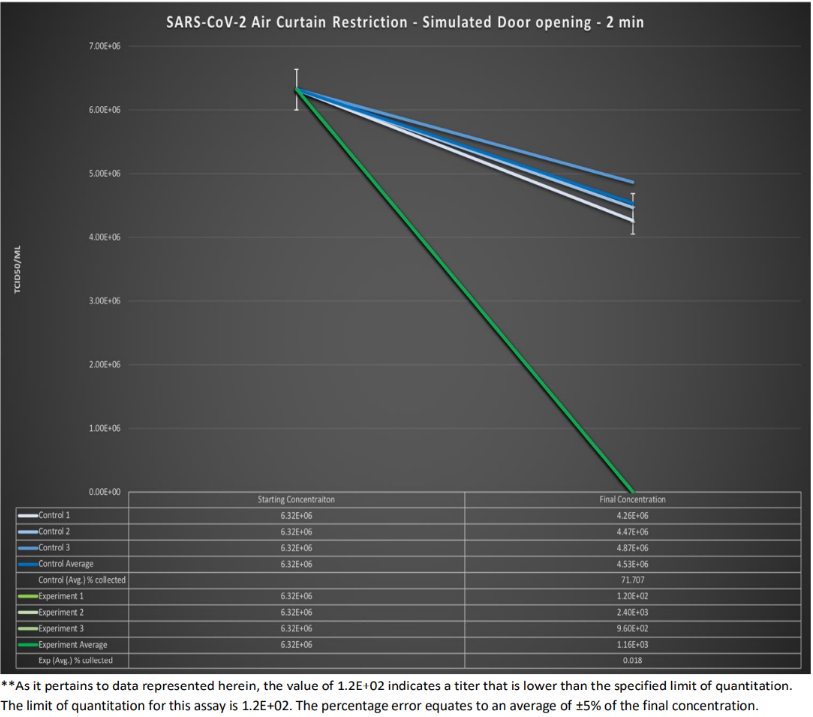 In summary, the results of the surface testing were nothing short of impressive. After just 30 minutes of operation, the concentration of SARS-CoV-2 was dramatically reduced to below quantification limits (>4.57 log* reduction). When it came to aerosol testing, the germicidal barrier proved to work as a forcefield, blocking an outstanding average of 99.98% (3.69 log) of active SARS-CoV-2 from entering during device operation. These noteworthy findings highlight the effectiveness and potential of this innovation in our ongoing battle against the virus.
In summary, the results of the surface testing were nothing short of impressive. After just 30 minutes of operation, the concentration of SARS-CoV-2 was dramatically reduced to below quantification limits (>4.57 log* reduction). When it came to aerosol testing, the germicidal barrier proved to work as a forcefield, blocking an outstanding average of 99.98% (3.69 log) of active SARS-CoV-2 from entering during device operation. These noteworthy findings highlight the effectiveness and potential of this innovation in our ongoing battle against the virus.
*Infectious disease scientists often use “log” (logarithmic) reduction to measure the efficacy of germicidal products. One log is a factor of ten. Two logs is a factor of one hundred. Three logs is a factor of one thousand. A typically-stated efficacy of something like hand sanitizer or alcohol wipes is 99% -- a 2 log reduction. An N95 mask is designed to block a minimum of 95% of certain contaminants, or about a 1.3 log reduction. Ion Bar blocks 99.98% of contaminants, or about a 3.69 log reduction – about 245 times better than an N95 mask.
Seeing The Results
When creating a new piece of technology like the Ion Bar, it's hard to not be skeptical. Garrett Goss, Associate Director of Engineering at AURA, recalls how the team felt going into their first round of testing, “As a team, we were somewhere between highly-skeptical and cautiously optimistic that it would work anywhere near as well it did," noting, "it's one thing to read the literature and see some evidence that this might work, but it’s another entirely to see results like this in real-world testing.”
When the test results came back, the AURA team was ecstatic. Dr. Blate specifically remembers seeing the 99.98% number and thinking, "Wow, okay, we did something really good here."
"There’s something I think a lot of people get wrong about science." Goss said regarding the Ion Bar testing. He continues, "They think it's about designing experiments to prove that you're right, when really, if you're doing that, you're just a bad scientist. Your job is to try everything you possibly can do to prove yourself wrong, and if you are unable to do so, then you might have something."
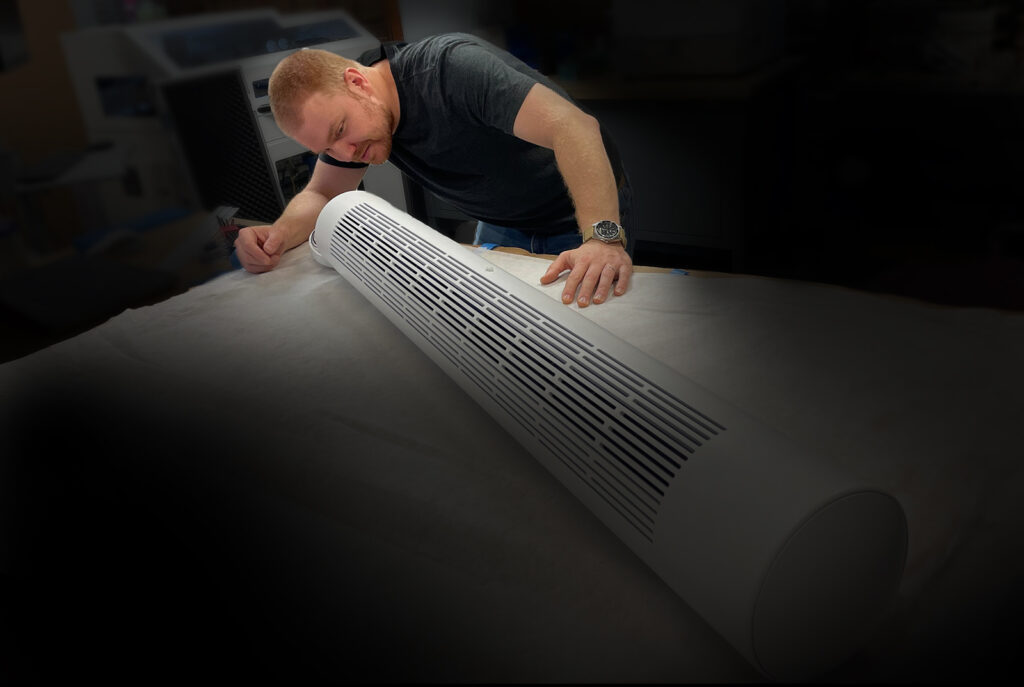
After receiving the test results, the AURA team knew they had something. Something that worked. Something that had been shown to reduce the transfer of Covid. Something that could change the indoor air quality space as we know it.
How and Why it Works
The "why" can be answered simply- our team dedicated countless hours of their time perfecting this product, and the test results reflect that.
The "how" is a bit more intricate.
Ion Bar is designed to create a protective sheet of air, enriched with a high concentration of negative air ions (NAIs) to create an invisible barrier. This barrier blocks contaminants before they enter your space, but also removes contaminants from your breathing zone. The flow separates air masses and pushes contaminants out of your breathing zone, while the NAIs are simultaneously inactivating the contaminants and causing them to form clumps and fall out of the air. This is why Ion Bar is like no other device on the market.
Dr. Blate says, explaining further, "One way to think of it is as an air curtain where you've dialed back the air velocity, and therefore dialed back the noise and the discomfort you get of walking through a 'hurricane.'" He continues, "A normal air curtain doesn't have any disinfecting properties, so when something makes it past the curtain, there's nothing to stop it from there – that is what the ions are for. They make up for the lower air velocity and they provide a second layer of defense. Anything that does make it past the barrier is likely to get inactivated or precipitated out of suspension by the ions before they're able to enter your space."
To learn more about how Ion Bar works, click here.
At the end of the day, the Ion Bar is more than just a symbol of innovative thinking and scientific testing. It's a beacon of hope in the ongoing battle against airborne diseases.
AURA Co- CEO, Anna Bennett said about Ion Bar, "We aimed to fight Covid-19 by creating something of value. After 3 years of dedicated development and successful lab studies, the astonishing results surpassed all expectations. Now, we're ready to share this technology and continue the fight against indoor air pathogens."
Ion Bar's incredible ability to significantly reduce active SARS-CoV-2 on surfaces and in the air demonstrates the potential for this technology to revolutionize the way we approach indoor air quality. But beyond that, what truly defines the value of the Ion Bar is its potential to restore a sense of safety and normalcy to our shared spaces.
Resources:
- Yee, Dana, et al. “AURA Technologies Ion Bar efficacy in SARS-COV-2 deactivation”. Innovative Bioanalysis, Inc. February 2022. AURATechnologies-IonBar-COVID-TestResults2022.pdf (auraionbar.com)
- Indoor air systems crucial to curbing spread of viruses, aerosol researchers say - CBS News
- AURA Ion Bar | AURA Ion Bar™
How to Avoid Streptococcal Pneumoniae This Flu Season
As flu season approaches, so does the increased risk of contracting Streptococcal pneumoniae, also known as pneumococcus. Streptococcus pneumoniae is a type of bacteria that can cause pneumococcal disease. There are more than 100 strains of these bacteria1, though it's important to note that not all strains result in infections. Interestingly, individuals can unknowingly carry the bacteria in their respiratory tract. Understanding the nature of pneumococcus, what dangers it poses, and reliable ways to avoid infection is essential during flu season.

What is Pneumococcus? What Risks Does It Pose?
Pneumococci bacteria are commonly found in the human respiratory tract. According to the Centers for Disease Control and Prevention (CDC), the percentage of carriers can range from 5% to 90%1, depending on age and setting. Out of all these, children usually carry the bacteria for a longer time than others. Despite these large numbers, only a small number of pneumococci lead to infection.
Those that do lead to infection can cause a range of issues impacting the lungs, brain, and other areas of the body. The symptoms may vary depending on the affected body part. Some of these infections include:
- Pneumonia with symptoms like cough, breathing difficulties, chest pain, fever or chills, and confusion.
- Meningitis with symptoms like headache, neck stiffness, fever, and sensitivity to light (photophobia)
- Sinusitis with symptoms like congestion, runny nose, facial pain, and headaches
- Bronchitis with symptoms like a productive cough, wheezing, shortness of breath, chest pain, and a low-grade fever
- Pneumococcus can, in some cases, lead to death.
To diagnose pneumococcal disease, doctors use a mix of physical examination, symptom evaluation, and lab tests. These tests are crucial in confirming the bacterial infection. Because pneumococcal diseases are bacterial, the go-to treatment typically involves taking a course of oral antibiotics.
Prevention
There are various strategies and measures you can take to prevent the contraction and spread of Streptococcus pneumoniae.
Hygiene and Isolation
Like many other respiratory diseases, S. pneumoniae is spread through airborne respiratory droplets found in coughs, sneezes, and more. Because of this, the bacteria are usually spread in households or crowded conditions.3
The most effective way to stop the spread is to avoid contact with others if you are symptomatic. If you can't avoid being around them, make it a habit to frequently wash your hands and diligently cover your mouth when you cough or sneeze. Masks can also offer levels of protection depending on the quality of the mask used and if it is used correctly. If you are going to be exposed to infected individuals, it can be beneficial to wear a mask, but don't forget to wash your hands after disposing of the mask.
Vaccines
The CDC recommends a pneumococcal vaccination for at-risk groups, children younger than five, and adults 65 years or older.4 There are four options for pneumococcus vaccination. Choosing the right one depends on many factors, so it is always recommended to talk with a medical professional to help determine which is right for you.
While the protection rate isn't 100%, pneumococcal vaccines still work to shield against most strains and related infections for both children and adults. Vaccines can also help to lessen the severity of infection.
Indoor Air Quality Systems
As a respiratory disease, pneumococcus spreads easily through coughing or sneezing. It can also survive on surfaces for a considerable amount of time, so touching your mouth, nose, or eyes after touching a contaminated object can lead to infection.
One efficient way in preventing the spread of pneumococcus is an in-home air quality system. While these systems are effective in slowly cleaning the air, they don’t target points of entry- like your front door. One innovative solution, AURA Ion Bar™, uses negative air ions to eliminate and deactivate pathogens at the entry point before they can enter your space. Ion Bar has also been lab tested to eliminate streptococcal pneumoniae on surfaces specifically, allowing you to feel safer in your home.
Learn more about AURA Ion Bar here.
Armed with the right knowledge, precautions, and preventive measures, we can significantly lower the risk of contracting this infection. Remember, prevention is always better than cure, so let's do our part to stay healthy.
This article has been reviewed and endorsed by Steve Cunnion, Ph.D., M.D., a world-renowned epidemiologist. Dr. Cunnion was the first person to alert the Western world of the SARS outbreak, for which he received the 2003 ProMED Reporting Award. Read more about Dr. Cunnion here.
Resources:
- Streptococcus pneumoniae: Information for Clinicians | CDC
- Photophobia (Light Sensitivity): Causes, Treatments & Prevention (healthline.com)
- Pneumococcal Disease Transmission: Information for Clinicians | CDC
- Pneumococcal Disease Prevention: Information for Clinicians | CDC
- About Pneumococcal Vaccine: For Providers | CDC
- Brooks, T, Behind the Mask; How the World Survived SARS. American Public Health Association, Washington, DC, 2005, p. 11
Preventing Aspergillus Fumigatus: Your Guide to a Fungus-Free Environment
Aspergillus Fumigatus, also known as A. Fumigatus, is a sneaky fungus that could be infecting your environment without your knowledge. This troublemaker in the mold world can cause various health problems if not addressed. In this article, we will discuss what A. fumigatus is, the associated health issues, and how to prevent its presence in your environment.
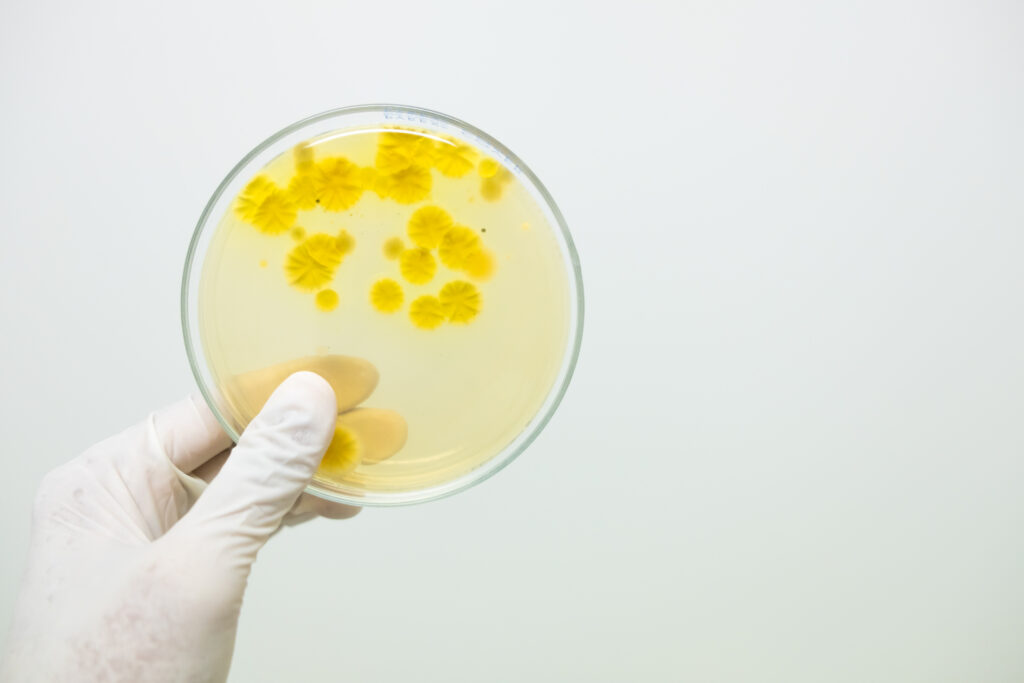
What is A. fumigatus?
Aspergillus fumigatus is a species of fungus that is found throughout the environment in things like soil, plant matter, and the dust in your house. The fungus can also produce airborne spores called conidia, which for most people, are safe to inhale. When a healthy individual inhales these spores, their immune system typically removes them from the body without leading to infection. However, for those who are sensitized, exposure to A. fumigatus can lead to a potentially-severe allergic reaction; and for at-risk groups and those who are immunocompromised, inhaling A. fumigatus can cause severe infection.
Any infection that’s caused by an Aspergillus species of fungus is called aspergillosis. There are many types of aspergillosis, such as:
All these infections cause harm to the airways and lungs and have the potential to be fatal if not treated by a medical professional.
Diagnosis and Treatments
Infections caused by A. fumigatus can be hard to diagnose due to the shared symptoms with other lung conditions. More than this, microscopic examinations can often be inconclusive because of the Aspergillus species appearing very similar to other fungal species. Though difficult to diagnose, medically professionals have many diagnostic methods for Aspergillus including things like sputum cultures to detect growth, chest X-rays, blood tests, and more.
The treatment for Aspergillosis depends on the type of infection and any underlying conditions you may have. Antifungals, corticosteroids, and surgery are the most common treatment options.
Prevention
Avoiding Contact
Avoiding activities that bring you face to face with Aspergillus is the main way to prevent infection. Activities like gardening, yard work, or visiting construction sites may expose you to higher levels of Aspergillus in the environment.
If you can't avoid these environments and are immunocompromised or otherwise susceptible to reaction or infection, make sure to wear long pants and sleeves. If you'll be handling soil or manure, wear gloves. Masks can also offer levels of protection depending on the quality of the mask used and if it is used correctly. If you are going to be exposed, it can be beneficial to wear a mask, but don't forget to wash your hands after disposing of the mask.
Routine Testing
At-risk groups may benefit from periodic testing for Aspergillus. Testing routinely could detect an infection in the early stages, which gives time to work with your provider on a treatment plan.
Indoor Air Quality Systems
The dust in your home can carry hundreds of different harmful contaminants, including Aspergillus. Fortunately, air ionizers can help lower the risk of infection by removing dust and other airborne contaminants from the environment.
One efficient way to help prevent the spread of A. fumigatus is an in-home air quality system. While these systems are effective in slowly cleaning the air, they don’t target points of entry- like your front door. One innovative solution, AURA Ion Bar™, uses negative air ions to eliminate and deactivate pathogens at the entry point before they can enter your space. Ion Bar has also been lab tested to eliminate up to 99.98% of A. fumigatus specifically. This lowers the chances of infection and provides you with a safe environment.
Learn more about AURA Ion Bar here.
To protect your health, it's important to keep your environment free of Aspergillus fumigatus. This is especially crucial if you're in an at-risk group. By understanding the risks, taking preventative measures, and getting regular testing, you can greatly reduce the chances of developing aspergillosis.
This article has been reviewed and endorsed by Steve Cunnion, Ph.D., M.D., a world-renowned epidemiologist. Dr. Cunnion was the first person to alert the Western world of the SARS outbreak, for which he received the 2003 ProMED Reporting Award. Read more about Dr. Cunnion here.
Resources:
- Conidium | Fungal Reproduction, Asexual Propagation & Germination | Britannica
- Aspergillus Fumigatus: Types, Conditions, Symptoms, and More (healthline.com)
- Aspergillosis: Types, Causes & Symptoms (healthline.com)
- Allergic Pulmonary Aspergillosis | Johns Hopkins Medicine
- Chronic Pulmonary Aspergillosis: Causes, Treatment, Outlook (healthline.com)
- Invasive aspergillosis: Symptoms and more (medicalnewstoday.com)
- Routine Sputum Culture: Purpose, Procedure, and Side Effects (healthline.com)
- Antifungals: What They Treat, How They Work & Side Effects (clevelandclinic.org)
- Corticosteroids (clevelandclinic.org)
- Brooks, T, Behind the Mask; How the World Survived SARS. American Public Health Association, Washington, DC, 2005, p. 11
Defending Against RSV: Prevention and Protection
Respiratory Syncytial Virus (RSV) is not only a common contagious virus but also a leading cause of other respiratory illnesses like bronchiolitis and pneumonia.1 Though many recover from RSV relatively easily, it does pose a larger risk for infants and elderly adults. In this article, we delve into what RSV is, its symptoms, and most importantly, measures one can take to prevent the spread of this common, yet potentially dangerous, virus.

What is RSV and Who Does it Affect?
RSV infects the lungs and respiratory tract, but presents as the common cold, sharing many similar symptoms. To many people, this is not a life-threatening virus – in fact, it is so common that most children will have had it by the time they're two years old.2 To others who are immunocompromised, infants, and elderly adults, RSV can be very dangerous. The symptoms present as a common cold with things like
- Runny nose
- Decrease in appetite
- Coughing
- Sneezing
- Fever
- Wheezing
While most people who contract RSV recover within a week or two, it is important to note that RSV can pose serious risks to those around us. Infants and older adults, in particular, are at a higher risk of developing severe RSV and could lead to hospitalization.1 This is why the prevention and awareness of RSV is so important.
Preventing RSV
As mentioned above, knowing how to prevent RSV is just as critical as understanding it. It's important to take preventative measures, especially in settings where vulnerable groups are present. Here are some of the most effective strategies to prevent the spread of this virus.
Avoiding Contact
One of the best ways to prevent the spread of RSV, especially to high-risk groups, is by avoiding contact when you have symptoms. If you're feeling stuffy, coughing, sneezing, running a fever, or wheezing, it's a good idea to keep your distance from vulnerable individuals. If you can't avoid being around them, remember to practice good hygiene: wash your hands often and cover your mouth when you cough or sneeze. With RSV, the asymptomatic rate is high, so if you discover you have been exposed to RSV within 7-10 days, it is recommended to wear a mask when you are around high-risk people. Masks can offer many levels of protection depending on the quality of the mask used and if it is used correctly.
Vaccination for High-Risk Groups
For infants, there are two options of vaccination. One is an RSV vaccine given during pregnancy, while the other is an RSV immunization that provides antibodies to your baby after birth. While neither are necessary, they can be beneficial.
Vaccination is particularly crucial for those over 60 who are at a higher risk of severe RSV infection.3 The frequency of receiving the RSV vaccine is determined by individual health conditions and the guidance provided by healthcare professionals. Talk to your healthcare provider to see if RSV vaccination is right for you.
For more information on where you can receive the RSV vaccine near you, click here.
Indoor Air Quality Systems
RSV is an easily spread virus. When RSV is contracted, the virus can live for hours on hard objects such as countertops, crib rails and toys.2 Touching your mouth, nose or eyes after touching a contaminated object may lead to infection.
One efficient way in preventing the spread of RSV is an in-home air quality system. While these systems are effective in slowly cleaning the air, they don’t target points of entry- like your front door. One innovative solution, AURA Ion Bar™, uses negative air ions to eliminate and deactivate pathogens at the entry point before they can enter your space. Ion Bar has also been lab tested to eliminate RSV on surfaces specifically, allowing you to feel safer in your home.
Learn more about AURA Ion Bar here.
RSV may be mild for some, but it can be severe for others, so it's our responsibility to protect those at risk. By taking preventive measures, we can significantly reduce the spread of this virus. Let's all do our part to stay informed and protect those around us from RSV. Your actions can make a real difference in the fight against this common, yet potentially dangerous, virus.
This article has been reviewed and endorsed by Steve Cunnion, Ph.D., M.D., a world-renowned epidemiologist. Dr. Cunnion was the first person to alert the Western world of the SARS outbreak, for which he received the 2003 ProMED Reporting Award. Read more about Dr. Cunnion here.
RESOURCES
- Symptoms and Care of RSV (Respiratory Syncytial Virus) | CDC
- Respiratory syncytial virus (RSV) - Symptoms & causes - Mayo Clinic
- Preventing RSV (Respiratory Syncytial Virus) | CDC
- Brooks, T, Behind the Mask; How the World Survived SARS. American Public Health Association, Washington, DC, 2005, p. 11
The Rising Importance of Indoor Air Quality
Last night, CBS's 60 Minutes aired an episode titled "Indoor air systems crucial in curbing the spread of viruses, say aerosol researchers." This is precisely what the AURA Ion Bar aims to address. Our team of researchers reached the same conclusion, which inspired the creation of Ion Bar.
"The original sin of the pandemic was the failure to recognize airborne transmission."
-Professor Joe Allen from Harvard's T.H. Chan School of Public Health
Despite people's best efforts to prevent the spread of Covid-19 early on, it continued to spread rapidly, which caught the attention of Linsey Marr, a professor at Virginia Tech University, and her fellow researchers. They were troubled by the fact that despite taking all necessary precautions, the virus persisted in spreading. While the medical community directed its attention towards droplets, surfaces, and handwashing, these researchers held a strong belief that Covid was largely transmitted through the air. However, they recognized the need for proof. As a result, they took it upon themselves to do their own analysis.
Marr recalls thinking, "This is even worse than I thought. This has to be airborne. There's really no other explanation for it."
Dr. Jon LaPook, in conversation with Professor Joe Allen, asked the question everyone was thinking. "If we'd had these indoor air quality targets before the pandemic, how do you think the pandemic would have unfolded differently?"
Allen responded saying, "We still would have had spread. This isn't an 'end-the-pandemic' thing. We would have had a lot less of it, and we would have a lot less of these superspreading events. Think about the early days of the pandemic, with 'flatten the curve'---'stay home.' Why wasn't 'Improve indoor air quality' part of 'flatten the curve' "?
Addressing these concerns was the very reason the AURA Ion Bar was created.
Regarding the episode, Greg Houlgate, EVP of Commercialization at AURA Technologies said, "The coverage by 60 minutes on the importance of indoor air quality is exactly why our team of skilled engineers, designers, and businesspeople have been working with key infrastructure groups across the globe to bring the AURA Ion Bar technology to life. We believe everyone has a right to live, work, shop and engage in healthy living indoors."
The AURA Ion Bar, recently featured in Newsweek, offers a remarkable solution to block the airborne transmission of many viruses, including Covid. The AURA team has done extensive testing through Bioanalysis that proved Ion Bar has the ability to reduce the transfer of airborne Covid by 99.98%. It's impressive how well it works in stopping the spread while also being carefully designed as a safe product that produces no measurable ozone.
How Does Ion Bar Work to Preserve Indoor Air Quality?
Ion Bar is designed to create a protective sheet of air, enriched with a high concentration of negative air ions (NAIs) to create an invisible barrier. This barrier blocks contaminants before they enter your space, but also removes contaminants from your breathing zone.
The flow separates air masses and pushes contaminants out of your breathing zone, while the NAIs are simultaneously inactivating the contaminants and causing them to form clumps and fall out of the air.
Alex Blate, PhD, AURA’s Chief Innovator, remarks that “AURA Ion Bar is a fundamental paradigm shift in thinking about air quality: real-time prevention versus long-term treatment. It reveals a fundamental gap in almost all air quality systems – a gap that Ion Bar uniquely and comprehensively closes.”
For a more detailed explanation, check out our article here.
Ion Bar was tested by Innovative Bioanalysis against Covid-19 specifically. The testing, available in detail here, showed that Ion Bar was a safe an effective way to reduce the transfer of Covid aerosols by 99.98%. It was also shown to neutralize Covid-19 on surfaces by 99.998% after 30 minutes of exposure. This means that with Ion Bar installed, your risk of contracting Covid in public (restrooms, grocery stores, etc.) or in your home is significantly reduced.
Considering everything we've experienced during the arrival and unfolding of Covid-19, it's inspiring to know that innovation continues to arise that will lead us towards a safer and healthier future. The introduction of the AURA Ion Bar hopes to bring the world one step closer to achieving this goal.
Learn more about the AURA Ion Bar here.
Resources
- Indoor air systems crucial to curbing spread of viruses, aerosol researchers say - CBS News
- AURA Ion Bar | AURA Ion Bar™
Do Air Ionizers Produce Harmful Ozone?
On their own, negative air ions (NAI) are safe. In fact, they are found in abundance all around us every day. For instance, a pot of boiling water creates significant concentrations of air ions.
Regarding air ionizers specifically, the question of safety is more complicated. Many air ionizers available in the market claim to be safe but lack thorough testing to justify their claims. Many manufacturers do not specify the ozone output, or the ion concentrations emitted by their products. Prioritizing research before purchasing an air ionizer is crucial to ensure that adequate testing has been conducted and the ionizer is indeed safe.
With research, you’ll find that air ionizers make an excellent addition to help keep your air clean and safe. Negative air ions have been shown to inactivate and block aerosol transmission of viruses and bacteria [1][2][3][4][5].
Defining Air Ionizers and Ozone
What is an Air Ionizer?
Air ionizers are devices designed to purify the air in your surroundings by emitting negatively charged ions. These ions attach to pollutants found in the air, such as dust, allergens, and bacteria, and either cause them to drop out of the air or be drawn into a filter within the device.
What Does Ozone Have to do With It?
Ozone plays a controversial role in air ionizers. It is a variant of oxygen (O3) often generated by air ionizers, which is intended to react with and kill airborne contaminants such as bacteria, mold, and odors. Ozone produced by ionizers can inactivate viruses in the air and on surfaces [6]. Though proven efficient in purifying the air, inhalation of high levels of ozone from an air ionizer can be detrimental to your health. Because of this, it’s important to ensure that any air ionizer you consider does not significantly increase the concentration of ozone in your indoor environment.
The Potential Effects of Ozone on Human Health
Ozone, when present in high concentrations, can have damaging effects on human health, particularly impacting the respiratory system. Chronic exposure to unsafe ozone levels can trigger a range of health issues including throat irritation, coughing, chest pain, and shortness of breath. It can exacerbate pre-existing conditions such as asthma and may lead to the development of more serious lung diseases. Moreover, a few studies have also linked high levels of ozone exposure to harmful effects on the cardiovascular system. Hence, it’s crucial to manage the levels of ozone in our living spaces to maintain a safe and healthy environment.
Is the Level of Ozone Produced by Air Ionizers Safe for Humans?
The safety of inhaling the level of ozone produced by air ionizers largely depends on the specific product and its operation. Some air ionizers produce negligible amounts of ozone, and are considered safe for humans and animals. However, other ionizers may generate ozone levels that exceed safety limits established by health organizations. Chronic exposure to such concentrations can potentially harm both humans and animals, leading to respiratory issues and other health complications. Therefore, when choosing an air ionizer, it is very important to ensure it has been tested and certified to recognized safety standards, indicating it does not produce harmful levels of ozone.
Different Types of Air Ionizers
There are primarily two types of air ionizers: electrostatic precipitators and ionizing purifiers. Electrostatic precipitators work by applying an electric charge to particles within the purifier, which are then attracted to plates with an opposite charge. These devices can effectively remove particulates from the air, but they
require regular cleaning of the plates. Ionizing purifiers, on the other hand, emit negatively charged ions that attach to airborne particles, making them clump together and more readily fall to the ground or attach to surfaces. While this method might not require regular cleaning like the former, it can leave surfaces around the home dusty.
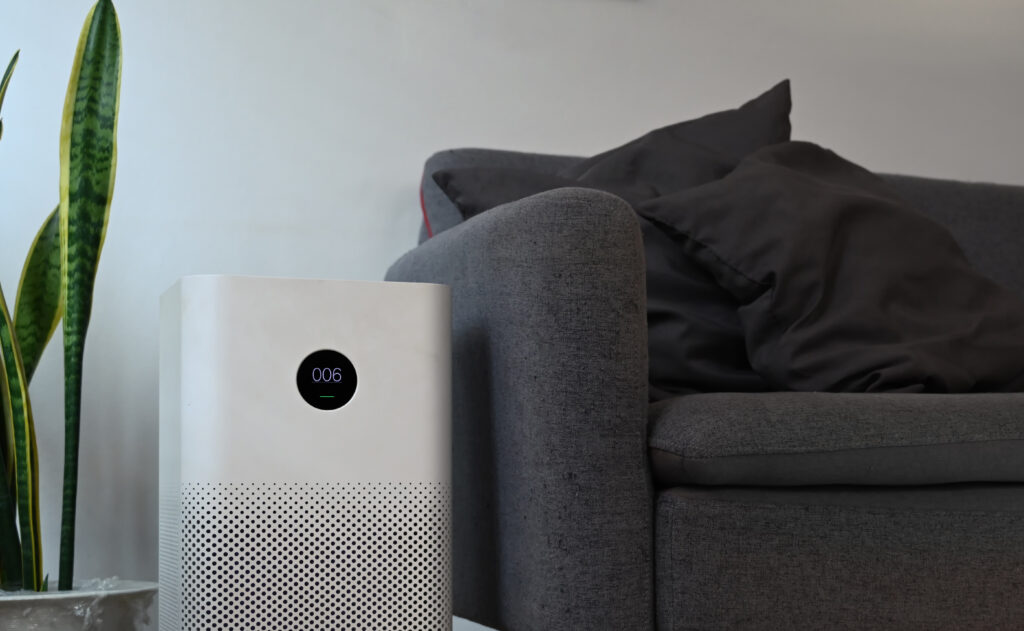
However, among the array of air ionizers available in the market, the AURA Ion Bar™ stands out for its superior performance and safety. The California Air Resources Board (CARB) limits emission for such devices at 0.050 ppm (parts per million). AURA Ion Bar has been tested extensively internally and by independent third parties for ozone production and was found to produce no detectable levels of ozone (less than 0.001 ppm).
While some air ionizers utilize specialized filters to eliminate ozone, safety risks still persist. When passing air through a carbon filter, the carbon is consumed (molecule-by-molecule) by this process and eventually is exhausted. That means that a device that relies on carbon filters for ozone-safety can become dangerous if its filters are not properly maintained. Unlike typical ionizers that eliminate ozone by means of filtration, Ion Bar operates safely without the need for a filter.
The AURA Ion Bar is a commendable option to consider. It is whisper-quiet, effective, and a filter-free solution that produces no measurable ozone.
So, Are Air Ionizers Safe or Not?
In conclusion, the safety of air ionization largely hinges on the specific product and its operation. While air ionizers can effectively purify the air by removing dust, allergens, and bacteria, they can also produce ozone, which can be harmful to human health when present in high concentrations. Therefore, it's crucial to choose an air ionizer that has been thoroughly tested and certified to not produce harmful levels of ozone. Among the products available, the AURA Ion Bar is set apart by its superior performance and commitment to ozone safety, ensuring a healthy and safe indoor environment while effectively purifying the air.
The AURA Ion Bar is set apart by its superior performance and commitment to ozone safety, ensuring a healthy and safe indoor environment while effectively purifying the air.
Learn more about Ion Bar here.
Resources
- Hagbom, Marie et al. “Ionizing air affects influenza virus infectivity and prevents airborne-transmission.” Scientific reports vol. 5 11431. 23 Jun. 2015, doi:10.1038/srep11431
- Zhang, Cheng et al. “Aerosol Transmission of the Pandemic SARS-CoV-2 and Influenza A Virus Was Blocked by Negative Ions.” Frontiers in cellular and infection microbiology vol. 12 897416. 29 Apr. 2022, doi:10.3389/fcimb.2022.897416
- Comini, Sara et al. “Positive and Negative Ions Potently Inhibit the Viability of Airborne Gram-Positive and Gram-Negative Bacteria.” Microbiology spectrum vol. 9,3 (2021): e0065121. doi:10.1128/Spectrum.00651-21
- Escombe, A Roderick et al. “Upper-room ultraviolet light and negative air ionization to prevent tuberculosis transmission.” PLoS medicine vol. 6,3 (2009): e43. doi:10.1371/journal.pmed.1000043
- Jiang SY, Ma A, Ramachandran S. Negative Air Ions and Their Effects on Human Health and Air Quality Improvement. Int J Mol Sci. 2018 Sep 28;19(10):2966. doi: 10.3390/ijms19102966. PMID: 30274196; PMCID: PMC6213340.
- Could ozone be an effective disinfection measure against the novel coronavirus (SARS-CoV-2)? – PMC (nih.gov)
- Are Ionic Air Purifiers (Ionizers) Safe or Bad for Your Health? | Home Air Guides
- California’s Air Cleaner Regulation (AB 2276) | California Air Resources Board
The Power of Negative Ions
The COVID-19 pandemic changed a lot- including our perception of health and wellness. This change accelerated the popularity of air purifiers and clean air initiatives. With increasing awareness of airborne transmission of viruses, people are seeking solutions to ensure their indoor air is as clean as possible. Maintaining a germ-free home can often feel like an insurmountable challenge, but that is where negative air ions (NAI) come in. These naturally occurring particles are invisible to the naked eye but pack a powerful punch when it comes to blocking contaminants.

Everything You Need to Know About Negative Air Ions
Air ions are molecules with an electrical charge. They’re unseen molecules that drift around in the air. Negative ions are molecules that have gained an electron, while positive ions are those that have lost an electron. An air ionizer is a device that emits negative ions into the air that attach themselves to tiny particles, like those in tobacco smoke or other air pollutants. The negative ions are attracted to airborne particles, causing them to gather and cluster together into larger, heavier particles. These larger particles fall out of the air faster, cleansing the air of unwanted pollutants.
Using NAIs for disinfection and to slow the spread of airborne pathogens has been studied heavily and has been shown to be safe. Negative air ions have been shown to inactivate and block aerosol transmission of viruses and bacteria [4][5][6][7]. Additionally, a 2018 review of NAI literature published in the International Journal of Molecular Science found consistent evidence that:
- NAIs can significantly reduce inhalable dust counts and particulate matter from the air.
- NAIs can kill or inhibit the growth of harmful bacteria, viruses, and mold species.
While NAIs are incredibly beneficial for air purification and overall health, it’s important to address a common concern associated with air ionizers: ozone emission.
Air Ionizers and Ozone Emission
While air ionizers are revered for their air purifying capabilities, it’s essential to consider their ozone output. Some ionizers are designed to manage their ozone production with HEPA filters or other mechanisms, preventing excessive ozone release into the environment. Many will show testing that complies with the strict limits published by the California Air Resources Board (CARB).
However, these filters or mechanisms are not without their downsides, and they require regular maintenance and replacement to remain effective. Neglecting to replace or clean a filter can lead to severe respiratory issues as the ozone output increases, and one inhales airborne pollutants that can no longer be effectively filtered out. According to U.S. Environmental Protection Agency, recent studies have shown that the efficiency of filters with permanent electrostatic fields drops significantly when the filters become dirty.1
Furthermore, these filters can significantly increase the total cost of ownership of the air ionizer. Therefore, while filtered air ionizers can be a great choice for those seeking cleaner indoor air, they require careful and regular upkeep to ensure they are safe and cost-effective.
In conclusion, the safety of air ionization is largely based on the specific product and its operation. While air ionizers can effectively purify the air by removing dust, allergens, and bacteria, they can also produce ozone, which can be harmful to human health when present in high concentrations. Therefore, it's crucial to choose an air ionizer that has been thoroughly tested and certified to not produce harmful levels of ozone. Among the products available, the AURA Ion Bar™ is set apart by its superior performance and commitment to ozone safety, ensuring a healthy and safe indoor environment while effectively purifying the air.
Learn more about Ion Bar here.
Resources
- Indoor Air Quality (IAQ) | US EPA
- Air purifiers in demand amid COVID-19 Delta surge, wildfires – Los Angeles Times (latimes.com)
- What is a HEPA filter? | US EPA
- Hagbom, Marie et al. “Ionizing air affects influenza virus infectivity and prevents airborne-transmission.” Scientific reports vol. 5 11431. 23 Jun. 2015, doi:10.1038/srep11431
- Zhang, Cheng et al. “Aerosol Transmission of the Pandemic SARS-CoV-2 and Influenza A Virus Was Blocked by Negative Ions.” Frontiers in cellular and infection microbiology vol. 12 897416. 29 Apr. 2022, doi:10.3389/fcimb.2022.897416
- Comini, Sara et al. “Positive and Negative Ions Potently Inhibit the Viability of Airborne Gram-Positive and Gram-Negative Bacteria.” Microbiology spectrum vol. 9,3 (2021): e0065121. doi:10.1128/Spectrum.00651-21
- Escombe, A Roderick et al. “Upper-room ultraviolet light and negative air ionization to prevent tuberculosis transmission.” PLoS medicine vol. 6,3 (2009): e43. doi:10.1371/journal.pmed.1000043
- Jiang SY, Ma A, Ramachandran S. Negative Air Ions and Their Effects on Human Health and Air Quality Improvement. Int J Mol Sci. 2018 Sep 28;19(10):2966. doi: 10.3390/ijms19102966. PMID: 30274196; PMCID: PMC6213340.




